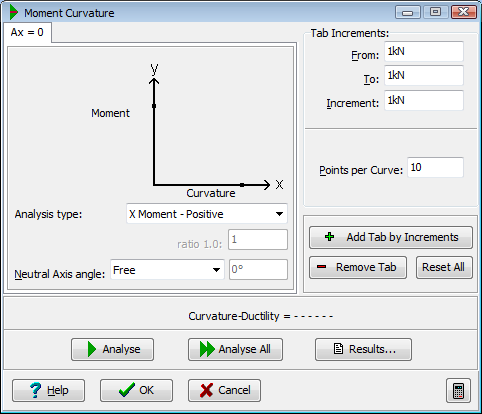Moment Curvature
Description
This form creates graphs of 'Curvature' versus 'Resolved Moment' for specified Axial Loadings ('Ax') on the defined section. Graphs include exact points of 'First Yield' and 'Ultimate Moment'.
'Tabs' are first created for each required 'Axial Loading' (compression) value. 'Tab' values are created by setting the fields in the 'Tab Increments' panel and then clicking on the Add Tab by Increments button.
The current 'Tab' value can be deleted by clicking the Remove Tab button. All 'Tab' values can be deleted by clicking the Reset All button.
The number of points on each curve may be varied from the default value up to a maximum of 100 points depending upon the resolution required.
Calculation is initiated by pressing the F6 key or clicking on the Analyse button.
Moment-curvature graphs can be viewed in tabular form by pressing the F5 key or clicking on the Results button. Tabular results may be cut and pasted.
One graph is generated for each tab that is successfully analysed. The graph corresponding to the current tab is displayed. Results for all the tabs may be calculated at the same time by clicking on the Analyse All button.
The Curvature-Ductility calculation ('Ultimate Moment Curvature' divided by 'Curvature at First Yield') for the current 'Tab' is displayed after successful analysis.
Comprehensive data checks are carried out (and warning messages issued) during calculation. For some column geometry and combinations of axial load and bending the iterative algorithms that are required for the solutions may not converge. Where it is impossible to create a graph none will be shown and the 'Curvature-Ductility' calculation will be undefined. Where some specific points on the curve cannot be calculated (but exact first yield and ultimate points can be calculated) then a 'best-stab' graph will be created (which may look unusual, with points missed or iterated over). Tabular results omit points to which warnings apply.
Form Graphic

Field Help
Analysis type
The direction in which the bending is applied during analysis is selected from the listed directions.
Ratio 1.0 :
This field is used only if 'X Moment & Y Moment' is selected. It is the ratio between the applied moments in each direction. The Moment-Curvature graph axis is 'Resolved Moment', which is the vector sum of the two applied moments.
Neutral Axis angle
For a section which is symmetrical about its y axis, and which has no applied moment about the y axis, the neutral axis (NA) will be horizontal. For all other cases it will not be horizontal.
Sometimes it may be advantageous to force the NA to be horizontal (e.g. modelling an edge beam which is rigidly connected to a stiff bridge deck, or modelling half of a symmetrical structure). This field enables that to be done, by selecting the option 'Fixed horizontal'. The NA will then be set to either 0 degrees or 180 degrees depending on the sign of the bending moments in the loading data.
The NA may be fixed to any angle by selecting the third option. This will make the next field available to define the angle.
(angle)
Access to this field is enabled only if 'Set angle to' has been selected in the previous field.
The angle required is the angle from the x axis to the neutral axis measured clockwise. The value must be in the range -180 to +180 (degrees) or -PI to +PI (radians).
Tab Increments
A range of values for 'Axial Loadings' may be set by using these fields to generate a tab page for each value required.
'From', 'To' and 'Increment' are the values used to generate new tabs.
- From - the value of the first new tab that will be generated.
- To - the value up to which new tabs will be generated.
- Increment - the difference between new tabs' values.
Tab pages are generated by clicking on the Add Tab by Increments button. The current tab page is removed by clicking on the Remove Tab button. All tab pages are removed by clicking on the Reset All button.
Points per Curve
Input the number of points that will make up a graph. The higher this value the smoother and more accurate the curve will be. The minimum number of points is 6 and the maximum is 100.
